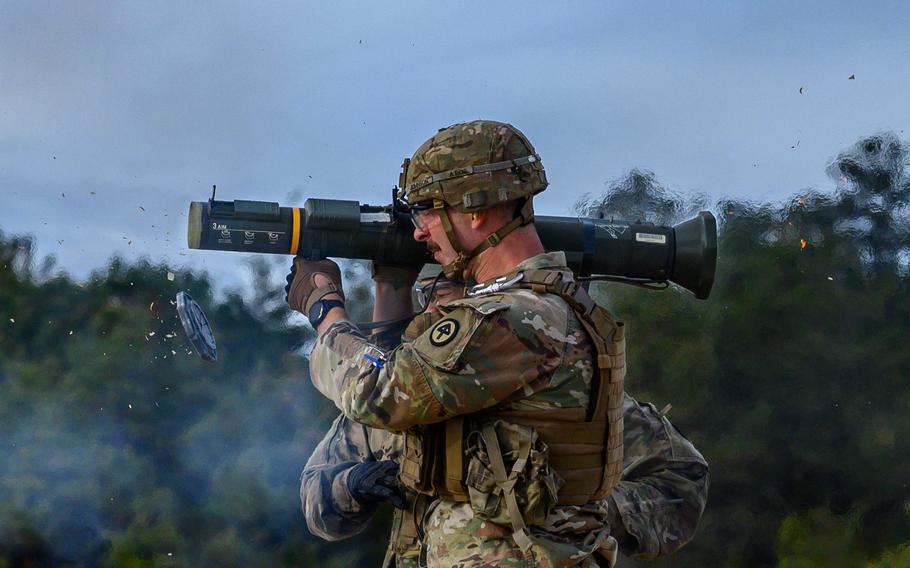
Soldiers fire the M136 AT4 at Joint Base McGuire-Dix-Lakehurst, N.J., on Nov. 17, 2023. The AT4 is a 84mm, disposable, shoulder-fired recoilless unguided anti-tank weapon. (Michael Schwenk/U.S. Army)
WASHINGTON — Senators on Wednesday said the Pentagon must collect better data on troop exposure to blast overpressure and identify those most at risk for traumatic brain injury at a much faster pace to protect the health of service members.
Lawmakers on the Senate Armed Services Committee’s personnel subpanel as well as experts on brain injury said the Pentagon has been too passive in addressing and preventing damage caused by shock waves that emanate from exploding weapons, known as overpressure.
The cumulative effect of repeated low-level blast exposure can cause headaches, seizures, hallucinations and increase risks of depression and suicide.
“I want to be a partner but a partner that urges you to move faster and deliver more for our service members as quickly as possible,” Sen. Elizabeth Warren, D-Mass., told Pentagon officials during a hearing on the issue. “We need to do better for our troops, and we need to do it right now.”
Frank Larkin, a former Navy SEAL who worked for a Pentagon organization focused on improvised explosive devices, said the health risks of blast exposure were a concern 15 years ago, when the U.S. was at war in Afghanistan and Iraq.
Those worries led to the creation of new armored vehicles to survive blasts but the service members inside them were not spared from the invisible pressure waves that rocked their bodies and brains, Larkin said.
“A lot of these folks came out of these vehicles and they looked fairly normal and it wasn’t until time evolved that we started to see behavioral changes, cognitive dysfunction and so forth,” he said.
Larkin said his Navy SEAL son, Ryan Larkin, became a different person after serving as a combat medic, sniper and explosives breacher in four combat tours in Iraq and Afghanistan. He stopped smiling, had trouble sleeping, complained of headaches and became convinced there was something wrong with his head.
Ryan Larkin was prescribed more than 40 medications for his ailments but in 2017, at 29-years-old, he died by suicide. A postmortem examination showed he had microscopic-level brain injury that was uniquely related to blast exposure, his father said.
“My son died from his injuries suffered both in training for combat and combat operations,” Larkin said. “He just didn’t die right away.”
Traumatic brain injury became known as the “signature wound” of the U.S. war on terror and continues to affect thousands of service members who train on weapons such as artillery and rocket launchers.
The Defense Department provided treatment for such injuries nearly 50,000 times during three months in 2023, according to Warren. More than 20,000 military personnel were diagnosed with traumatic brain injury in 2022, said Sen. Rick Scott, R-Fla.
“The more we learn, the more we come to understand that blast exposure is an ongoing threat to the health of individual service members and to the wellbeing, the morale and the readiness of our entire force,” Warren said.
Lawmakers have for years urged the Pentagon to be more proactive in protecting troop brain health, ramping up pressure on officials last year after a New York Times investigation revealed the military’s mitigation policies were having little to no effect on the ground.
Pentagon officials on Wednesday said they are taking steps to improve data collection and blast exposure records, which experts said is key for tracking exposure in high-risk occupational specialties and developing strategies to limit exposure in training environments.
The Defense Department only has blast exposure data for 500 service members, Warren said. Some of the highest rates of exposure are seen among training instructors and members of the artillery community.
Dr. Carlos Williams, director of the National Intrepid Center of Excellence at the Walter Reed National Military Medical Center, said cognitive assessments will be performed on all new troops this year before they participate in training.
“One of the most important things we can do is baseline our members from the moment they come into the military,” he said. “And so that means before they start the military training, and that allows us to follow them over time.”
Lester Martinez-Lopez, the assistant secretary of defense for health affairs, said the Pentagon is looking into how often subsequent testing should be done. Special Operations Command has determined its members should be tested every three years while the Pentagon is planning on every five years.
Martinez-Lopez said the Defense Department needed to sort through more “data and science” to determine if testing should be more frequent.
Kathy Lee, director of the Pentagon’s warfighter brain health policy, said more research was also required before establishing safety thresholds for firing explosive weapons.
Warren and other senators said the Pentagon needed to act now.
“We know enough to start moving in the right direction,” she said. “I urge you: better to make your best estimate and get started.”
shkolnikova.svetlana@stripes.com Twitter: @svetashko